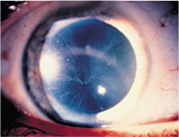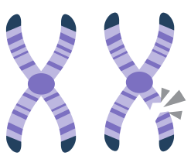We found answers. We found support. We found out we are not alone.
WE FOUND THE FACTS ABOUT FABRY.
Fabry disease is a genetic disorder that runs in families. Fabry disease is found in roughly 1 in 40,000 males, and 1 in 20,000 females. Too often, Fabry disease symptoms go unrecognized and misdiagnosed. If Fabry disease is diagnosed early, doctors can begin appropriate management of symptoms. Don’t wait. Get the facts to help you and your family identify and manage Fabry disease.
Sarah and Stephanie, living with Fabry disease.
Fabry disease is progressive, so early diagnosis is important.
What is Fabry disease?
Fabry disease is an inherited condition, meaning it runs in families. Fabry disease is a lifelong condition that can get worse over time. And it can be hard to diagnose. Therefore, it is important to find a doctor who has a good understanding of the disease. If you think you or a family member may have Fabry disease, talk to a doctor as soon as possible.
What causes Fabry disease?
Fabry disease is caused by alterations in the GLA gene. This gene produces an enzyme called alpha-galactosidase A, or alpha-GAL. Alterations in the GLA gene result in reduced alpha-GAL production.
What is the importance of alpha-GAL?
Alpha-GAL is responsible for clearing a fatty substance called globotriaosynceramide, or GL-3. Reduced alpha-GAL can result in buildup of GL-3, which can cause damage to tissues throughout the body.
How does Fabry disease affect your cells?

Watch the video
What are the symptoms of Fabry disease?
Fabry disease is commonly misdiagnosed or undiagnosed because the symptoms can occur in other more well-known conditions. Symptoms can also vary widely, even within the same family. An individual with Fabry disease may experience only one symptom, or all of them, and symptoms may range from mild to severe. Some people do not even know they have Fabry disease until they experience serious health problems such as stroke, heart attack, or kidney failure.
Use this Interactive Symptom Finder to view common signs of Fabry disease.

Occasional episodes of intense, burning pain that usually start in the hands and feet, and can often spread to other parts of the body. When Fabry pain is severe and persists for several days or longer, it is referred to as a "Fabry crisis." Fabry crises can be debilitating, may last for several days, and may result in a trip to the emergency room to get assistance with pain relief. Episodic pain can also be brought on by changes in weather, exposure to hot temperatures, stress, exercise, and/or fatigue. Pain may also be exacerbated when you have a fever.
Although the causes of fatigue in Fabry disease are not well understood, it is a common symptom of the disease. Some people with Fabry disease are unable to tolerate physical exertion, and may tire or become overheated even after mild activity. Physical exertion can also trigger episodes of pain. People with Fabry disease may need to modify their physical activities and/or avoid certain activities altogether.
Many people with Fabry disease either perspire very little (hypohidrosis) or not at all (anhidrosis). This can cause overheating, frequent fevers, and sensitivity to extremes in temperature. Impaired sweating is generally caused by damage to the nerves and sweat glands. Impaired sweating, along with pain in the hands and feet, is often one of the earliest signs of Fabry disease in childhood.
Another common sign of Fabry disease is corneal whorling, a distinctive starburst pattern on the cornea caused by GL-3 accumulation. Over 70% of males and females with Fabry disease have corneal whorling. Corneal whorling can only be seen through a slit-lamp ophthalmoscopy exam. It typically does not affect vision. Tortuous vessels are another symptom of Fabry disease.

*If your eye doctor notices corneal whorling (lines on your cornea that will probably not affect your vision), you should get tested for Fabry disease.
People with Fabry disease can experience recurrent fever. Recurrent fever is often accompanied by pain.
Temperature sensitivity is common in Fabry disease. It presumably results from lipid deposition in small vessel walls, perineural cells, and unmyelinated or myelinated nerve cells resulting in small fiber neuropathy.
Many people with Fabry disease experience chronic stomach problems, which can range from mild to severe. These disturbances may include pain after eating a meal, diarrhea, constipation, vomiting and nausea.
Fabry can cause premature cardiac problems. As GL-3 accumulates over many years, progressive damage can occur to the tissues of the heart, as well as to the blood vessels that supply the heart. Heart problems due to Fabry disease may include:
- Thickening (hypertrophy) of the muscle wall of the heart’s left chamber (ventricle)
- Malfunctioning heart valves
- Hypertension
- Irregular heartbeat (arrhythmias)
- Heart failure
- Heart attack
After years of GL-3 build-up, problems with the kidneys can develop, and kidney function may become compromised. Kidney damage can become so severe that the kidneys do not function properly (renal insufficiency) or may fail (renal failure). Thus, GL-3 accumulation in the kidneys represents a major health risk for those with Fabry disease. However, kidney problems are not unique to Fabry disease. Often, it is other signs and symptoms (like pain and angiokeratomas) that may lead a doctor to suspect Fabry disease.
Signs of kidney problems may include:
- Proteinuria (protein in urine, detected by a urine test)
- Microalbuminuria (excess albumin in urine, detected by a urine test)
- Chronic kidney disease
Significant GL-3 accumulation can thicken small blood vessels in the brain. As a result, people may experience a number of symptoms including:
- Weakness
- Headache
- Numbness
- Dizziness
- Stroke/Transient Ischemic Attacks (TIAs)
Hearing loss and tinnitus (ringing in the ears).
In addition to physical symptoms, individuals with Fabry disease may also have depression and anxiety. Fear, guilt, and shame are common emotions when Fabry patients discover they have passed on the disease to their family. While it is easy to become frustrated and discouraged, consider talking to your doctor and family about how you feel. To help you cope with these feelings, there are support groups specifically for people with Fabry disease, as well as support groups for rare diseases generally.

Occasional episodes of intense, burning pain that usually start in the hands and feet, and can often spread to other parts of the body. When Fabry pain is severe and persists for several days or longer, it is referred to as a "Fabry crisis." Fabry crises can be debilitating, may last for several days, and may result in a trip to the emergency room to get assistance with pain relief. assistance with pain relief. 'Episodic pain' can also be brought on by changes in weather, exposure to hot temperatures, stress, exercise, and/or fatigue. Pain may also be exacerbated when you have a fever.
Although the causes of fatigue in Fabry disease are not well understood, it is a common symptom of the disease. Some people with Fabry disease are unable to tolerate physical exertion, and may tire or become overheated even after mild activity. Physical exertion can also trigger episodes of pain. People with Fabry disease may need to modify their physical activities and/or avoid certain activities altogether.
Many people with Fabry disease either perspire very little (hypohidrosis) or not at all (anhidrosis). This can cause overheating, frequent fevers, and sensitivity to extremes in temperature. Impaired sweating is generally caused by damage to the nerves and sweat glands. Impaired sweating, along with pain in the hands and feet, is often one of the earliest signs of Fabry disease in childhood.
Another common sign of Fabry disease is corneal whorling, a distinctive starburst pattern on the cornea caused by GL-3 accumulation. Over 70% of males and females with Fabry disease have corneal whorling. Corneal whorling can only be seen through a slit-lamp ophthalmoscopy exam. It typically does not affect vision. Tortuous vessels are another symptom of Fabry disease.

*If your eye doctor notices corneal whorling (lines on your cornea that will probably not affect your vision), you should get tested for Fabry disease.
People with Fabry disease can experience recurrent fever. Recurrent fever is often accompanied by pain.
Temperature sensitivity is common in Fabry disease. It presumably results from lipid deposition in small vessel walls, perineural cells, and unmyelinated or myelinated nerve cells resulting in small fiber neuropathy.
Many people with Fabry disease experience chronic stomach problems, which can range from mild to severe. These disturbances may include pain after eating a meal, diarrhea, constipation, vomiting and nausea.
Fabry can cause premature cardiac problems. As GL-3 accumulates over many years, progressive damage can occur to the tissues of the heart, as well as to the blood vessels that supply the heart. Heart problems due to Fabry disease may include:
- Thickening (hypertrophy) of the muscle wall of the heart’s left chamber (ventricle)
- Malfunctioning heart valves
- Hypertension
- Irregular heartbeat (arrhythmias)
- Heart failure
- Heart attack
After years of GL-3 build-up, problems with the kidneys can develop, and kidney function may become compromised. Kidney damage can become so severe that the kidneys do not function properly (renal insufficiency) or may fail (renal failure). Thus, GL-3 accumulation in the kidneys represents a major health risk for those with Fabry disease. However, kidney problems are not unique to Fabry disease. Often, it is other signs and symptoms (like pain and angiokeratomas) that may lead a doctor to suspect Fabry disease.
Signs of kidney problems may include:
- Proteinuria (protein in urine, detected by a urine test)
- Microalbuminuria (excess albumin in urine, detected by a urine test)
- Chronic kidney disease
Significant GL-3 accumulation can thicken small blood vessels in the brain. As a result, people may experience a number of symptoms including:
- Weakness
- Headache
- Numbness
- Dizziness
- Stroke/Transient Ischemic Attacks (TIAs)
Hearing loss and tinnitus (ringing in the ears).
In addition to physical symptoms, individuals with Fabry disease may also have depression and anxiety. Fear, guilt, and shame are common emotions when Fabry patients discover they have passed on the disease to their family. While it is easy to become frustrated and discouraged, consider talking to your doctor and family about how you feel. To help you cope with these feelings, there are support groups specifically for people with Fabry disease, as well as support groups for rare diseases generally.

Occasional episodes of intense, burning pain that usually start in the hands and feet, and can often spread to other parts of the body. These are called “Fabry crises,” and can be debilitating. Fabry crises may last anywhere from minutes to several days, and may result in a trip to the emergency room to get assistance with pain relief. Episodic pain can also be brought on by changes in weather, exposure to hot temperatures, stress, exercise, and/or fatigue. Pain may also be exacerbated when you have a fever.
Although the causes of fatigue in Fabry disease are not well understood, it is a common symptom of the disease. Some people with Fabry disease are unable to tolerate physical exertion, and may tire or become overheated even after mild activity. Physical exertion can also trigger episodes of pain. People with Fabry disease may need to modify their physical activities and/or avoid certain activities altogether.
Many people with Fabry disease either perspire very little (hypohidrosis) or not at all (anhidrosis). This can cause overheating, frequent fevers, and sensitivity to extremes in temperature. Impaired sweating is generally caused by damage to the nerves and sweat glands. Impaired sweating, along with pain in the hands and feet, is often one of the earliest signs of Fabry disease in childhood.
Another common sign of Fabry disease is corneal whorling, a distinctive starburst pattern on the cornea caused by GL-3 accumulation. Over 70% of males and females with Fabry disease have corneal whorling. Corneal whorling can only be seen through a slit-lamp ophthalmoscopy exam. It typically does not affect vision. Tortuous vessels are another symptom of Fabry disease.

*If your eye doctor notices corneal whorling (lines on your cornea that will probably not affect your vision), you should get tested for Fabry disease.
People with Fabry disease can experience recurrent fever. Recurrent fever is often accompanied by pain.
Temperature sensitivity is common in Fabry disease. It presumably results from lipid deposition in small vessel walls, perineural cells, and unmyelinated or myelinated nerve cells resulting in small fiber neuropathy.
Many people with Fabry disease experience chronic stomach problems, which can range from mild to severe. These disturbances may include pain after eating a meal, diarrhea, constipation, vomiting and nausea.
Hearing loss and tinnitus (ringing in the ears).
In addition to physical symptoms, individuals with Fabry disease may also have depression and anxiety. Fear, guilt, and shame are common emotions when Fabry patients discover they have passed on the disease to their family. While it is easy to become frustrated and discouraged, consider talking to your doctor and family about how you feel. To help you cope with these feelings, there are support groups specifically for people with Fabry disease, as well as support groups for rare diseases generally.

Occasional episodes of intense, burning pain that usually start in the hands and feet, and can often spread to other parts of the body. When Fabry pain is severe and persists for several days or longer, it is referred to as a "Fabry crisis." Fabry crises can be debilitating, may last for several days, and may result in a trip to the emergency room to get assistance with pain relief. Episodic pain can also be brought on by changes in weather, exposure to hot temperatures, stress, exercise, and/or fatigue. Pain may also be exacerbated when you have a fever.
Although the causes of fatigue in Fabry disease are not well understood, it is a common symptom of the disease. Some people with Fabry disease are unable to tolerate physical exertion, and may tire or become overheated even after mild activity. Physical exertion can also trigger episodes of pain. People with Fabry disease may need to modify their physical activities and/or avoid certain activities altogether.
Many people with Fabry disease either perspire very little (hypohidrosis) or not at all (anhidrosis). This can cause overheating, frequent fevers, and sensitivity to extremes in temperature. Impaired sweating is generally caused by damage to the nerves and sweat glands. Impaired sweating, along with pain in the hands and feet, is often one of the earliest signs of Fabry disease in childhood.
Another common sign of Fabry disease is corneal whorling, a distinctive starburst pattern on the cornea caused by GL-3 accumulation. Over 70% of males and females with Fabry disease have corneal whorling. Corneal whorling can only be seen through a slit-lamp ophthalmoscopy exam. It typically does not affect vision. Tortuous vessels are another symptom of Fabry disease.

*If your eye doctor notices corneal whorling (lines on your cornea that will probably not affect your vision), you should get tested for Fabry disease
People with Fabry disease can experience recurrent fever. Recurrent fever is often accompanied by pain.
Temperature sensitivity is common in Fabry disease. It presumably results from lipid deposition in small vessel walls, perineural cells, and unmyelinated or myelinated nerve cells resulting in small fiber neuropathy.
Many people with Fabry disease experience chronic stomach problems, which can range from mild to severe. These disturbances may include pain after eating a meal, diarrhea, constipation, vomiting and nausea.
Hearing loss and tinnitus (ringing in the ears).
In addition to physical symptoms, individuals with Fabry disease may also have depression and anxiety. Fear, guilt, and shame are common emotions when Fabry patients discover they have passed on the disease to their family. While it is easy to become frustrated and discouraged, consider talking to your doctor and family about how you feel. To help you cope with these feelings, there are support groups specifically for people with Fabry disease, as well as support groups for rare diseases generally.
This is not a complete list of all Fabry symptoms. Only a doctor can diagnose Fabry disease. If you have experienced two or more of these symptoms, or if you have a family history of relatives with these symptoms, it may be time to speak to a specialist.
Are Fabry symptoms different depending on age?
GL-3 accumulation begins before birth and continues for decades. As a result, Fabry disease symptoms can change over time. Neuropathic pain (burning, tingling pain that mainly affects the hands and feet) is the most common symptom of Fabry disease and is often the first symptom that brings children and adolescents to their doctor. Children may experience recurrent fever, and children and teens may suffer from heat and cold intolerance, gastrointestinal problems, and a skin condition (angiokeratomas). By adulthood, many people with Fabry disease will have serious kidney, heart, or nervous system problems in addition to the symptoms previously described.
Why is early diagnosis important?
Fabry disease is a systemic condition, which means it can affect the whole body. The ongoing build-up of GL-3 causes the blood vessels to become narrowed. As a result, the kidneys, heart, and brain do not get the blood flow they need to function properly. People with Fabry disease can experience life-threatening damage to major organ systems (e.g., stroke at a young age), which can worsen over time. This is why early diagnosis is so important. If you have a family history of Fabry disease, consider being tested even if you are not experiencing symptoms. The earlier Fabry disease is recognized, the sooner monitoring and management can begin.
Females can have Fabry disease too
It was once thought that Fabry disease only affected males. Females were told they were only “carriers,” meaning they carried the gene for the disorder without developing symptoms. We now know this is not true. Both males and females can get Fabry disease, although it may manifest differently depending on sex. Research has shown that females with Fabry disease do, in fact, experience a wide range of significant symptoms.
Fabry disease symptoms vary more in females than in males. Most males with Fabry disease will experience the full range of symptoms described here. Many females develop symptoms over time. Females who are symptomatic often develop brain, heart, and kidney abnormalities later in life.
Undiagnosed and unmanaged, Fabry disease may reduce life expectancy by up to 16 years for males and 5-14 years for females.
Viviana, living with Fabry disease.
Why do females experience Fabry disease differently from males?
The altered gene (called the GLA gene) that causes Fabry disease is on the X chromosome. Females have two X chromosomes, but males only have one. For males who have Fabry disease, their only X chromosome is the one that has the altered gene. And that X chromosome is in every one of their cells.

In females, the altered gene is only in one of the two X chromosomes they have. In every cell only one of the two X chromosomes activates – it may or may not be the one with the altered gene. This random process where one of the X chromosomes becomes inactivated (turned off) before birth is called “X-inactivation.”

For females with Fabry disease, this X-inactivation results in a mix of cells with a working/active GLA gene and cells with a non-working/inactive GLA gene. This mix of cells with working and nonworking copies of the GLA gene (also called “mosaicism”) causes the range of symptoms in females with Fabry.
Depending on their X-inactivation pattern, females can experience a number of health complications, including but not limited to:

Heart problems

Stroke

Impaired kidney function

Skin and nerve conditions

Stomach disorders

“When we first started going to different doctors, we were literally written off. I had a doctor tell me, ʻYouʼre just a carrier. You donʼt have it.ʼ I said, ʻBaloney, I do have it and I do have symptoms.ʼ Today, itʼs not ʻcarrierʼ anymore. You do have the disease. You have more support. They will listen to you.”
Jodie, living with Fabry disease.
Females with Fabry can have a variety of symptoms, so itʼs important to visit doctors regularly.
See one familyʼs journey with Fabry disease
Four generations of females with Fabry

Watch the video
Fabry and families
Fabry disease is an inherited disorder that can be potentially life-threatening. Once one person has been diagnosed with Fabry disease, it is likely that other family members will also be at risk for the disease. That is why it is important for other family members to be tested for Fabry disease as soon as possible, so they can get appropriate care.







